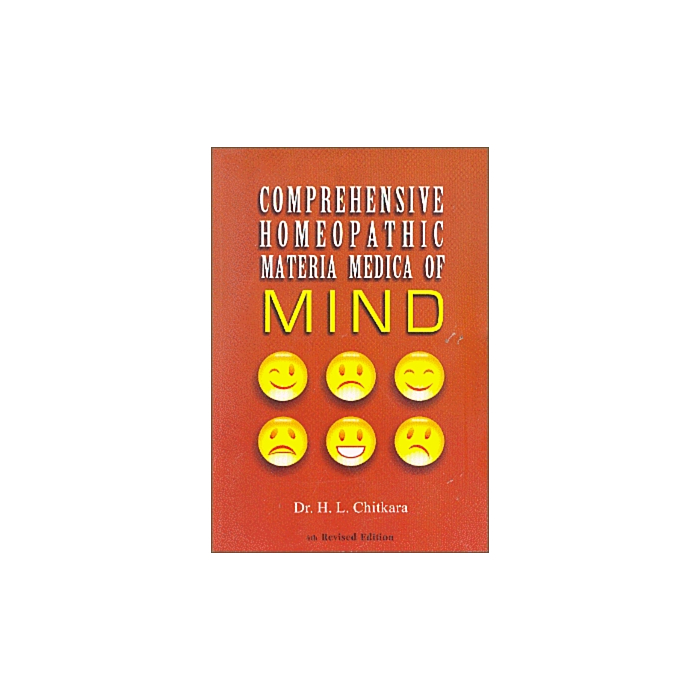New Comprehensive Homoeopathic Materia Medica of Mind
Share on social media
An improvement on the Agrawal book, Materia Medica of the Human Mind
The New Comprehensive Homeopathic Materia Medica Of Mind covers 892 medicines and is made up of rubrices of Mind mostly from the Synthetic Repertory Vol I, with additions from other authentic sources. With numerous corrections and elucidations of the original texts,it is a more comprehensive, more authentic, more accurate and more elucidated compilation than any other work of its kind. It will prove to be an invaluable book of reference besides serving as a useful handbook of daily practice.
| ISBN | 9788131903582 |
|---|---|
| Author | Dr. H.L. Chitkara |
| Type | Hardback |
| Language | English |
| Publication date | 2005 |
| Pages | 691 |
| Publisher | B. Jain |
| Review | This book review is reprinted with the permission of the International Foundation for Homeopathy Many North American homeopaths are not very familiar with the Synthetic Repertory. In Europe and India, on the other hand, the Synthetic Repertory has been considered indispensable. This repertory focuses on the mind, sleep, dreams, sexuality, and generals. My husband and I were introduced to the Synthetic Repertory during our study in Bombay a year ago and have found it extremely useful ever since. What, you may ask, does this have to do with Chitkara's new book? The Chitkara book is an extraction of the MIND rubrics of each remedy from the Synthetic Repertory. Chitkara dedicates his book "to the authors of Synthetic Repertory, Barthel and Klunker, who dared touch the sacred cow." The style is similar to M.L. Agarwal's Materia Medica of the Human Mind, which is an extraction of MIND rubrics from Kent's Repertory. Chitkara's new book is much more readable and complete. Most, but not all, remedies are included. It lacks the advantage of listing single rubrics (rubrics in which the particular remedy is the only remedy listed in the repertory) at the beginning of each rubric extraction, but does indicate them with dots. Additions to the rubrics are marked by asterisks. So, how is one to use this book? When studying a case, after understanding what is unique about the person, honing in on key elements of the case, and selecting rubrics which best fit the case, we are led to particular remedies. Some of those remedies are ones with which we are already familiar. As we select rubrics, we see other remedies about which we know nothing. Or, we may be aware of a keynote but know nothing else about the remedy. This is where the Chitkara book is invaluable. We look up those unfamiliar remedies in his book and can get an immediate feeling for the mental and emotional state of a person needing that remedy. It gives us a flavor of the remedy picture. If it appears that the state fits our patient, we use Reference Works (another comparable computer program or the books themselves would serve the same purpose) to read more about the unfamiliar remedy. This has helped us many times to prescribe small remedies for the first time. This book occupies a prominent place among the books we use on a daily basis to study cases. RESONANCE MAY-JUNE 1995 |
Review
This book review is reprinted with the permission of the International Foundation for Homeopathy
PO Box 7
Edmonds, WA 98020
Reviewed by Judyth Reichenberg- Ullman, ND, DHANP
Many North American homeopaths are not very familiar with the Synthetic Repertory. In Europe and India, on the other hand, the Synthetic Repertory has been considered indispensable. This repertory focuses on the mind, sleep, dreams, sexuality, and generals. My husband and I were introduced to the Synthetic Repertory during our study in Bombay a year ago and have found it extremely useful ever since. What, you may ask, does this have to do with Chitkara's new book? The Chitkara book is an extraction of the MIND rubrics of each remedy from the Synthetic Repertory. Chitkara dedicates his book "to the authors of Synthetic Repertory, Barthel and Klunker, who dared touch the sacred cow." The style is similar to M.L. Agarwal's Materia Medica of the Human Mind, which is an extraction of MIND rubrics from Kent's Repertory. Chitkara's new book is much more readable and complete. Most, but not all, remedies are included. It lacks the advantage of listing single rubrics (rubrics in which the particular remedy is the only remedy listed in the repertory) at the beginning of each rubric extraction, but does indicate them with dots. Additions to the rubrics are marked by asterisks.
So, how is one to use this book? When studying a case, after understanding what is unique about the person, honing in on key elements of the case, and selecting rubrics which best fit the case, we are led to particular remedies.
Some of those remedies are ones with which we are already familiar. As we select rubrics, we see other remedies about which we know nothing. Or, we may be aware of a keynote but know nothing else about the remedy.
This is where the Chitkara book is invaluable. We look up those unfamiliar remedies in his book and can get an immediate feeling for the mental and emotional state of a person needing that remedy. It gives us a flavor of the remedy picture. If it appears that the state fits our patient, we use Reference Works (another comparable computer program or the books themselves would serve the same purpose) to read more about the unfamiliar remedy.
This has helped us many times to prescribe small remedies for the first time. This book occupies a prominent place among the books we use on a daily basis to study cases.
RESONANCE MAY-JUNE 1995

